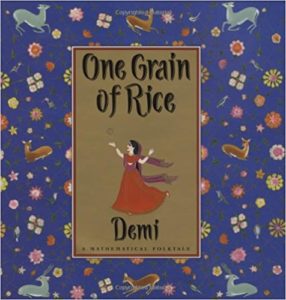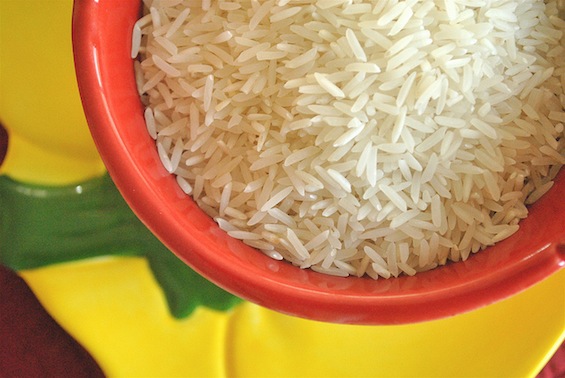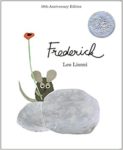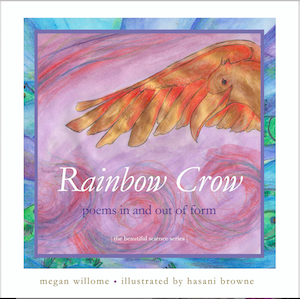
It was my understanding that there would be no math.”
— Chevy Chase, impersonating President Gerald Ford in a Saturday Night Life sketch of yore
Math is my bugaboo. That’s why when a friend suggested One Grain of Rice: A Mathematical Folktale for our next children’s book club, I agreed.
At its most basic level, this is a story about how 1 grain of rice becomes more than 1 billion grains of rice. How? Math. If 1 grain of rice is doubled every day for 30 days, and all those amounts are added together, then you get 1,073,741,823 grains of rice. There’s a chart on the last page of the book that explains the arithmetic.
If someone handed me the chart, I would not care. But give me the math in a story — better yet, a folktale (this one comes from India) — and I’m all in.
Charlotte Dumaresq Hunt, aka Demi, the artist and author, studied art in India, where she lived for two years. She’s written more than 300 books, many of them about religious figures, including Muhammed, The Dalai Lama, and Jesus. Her newest book, released this month, is Talking to God: Prayers for Children from the World’s Religions.
The hero of One Grain of Rice, a young woman named Rani, is clever. She’s also bold. She tricks the raja into sharing his hoarded rice with the starving people. The story has both a math lesson and a moral lesson.
On the first page of the book, the raja “believed that he was wise and fair, as a raja should be,” and by the final page, he has become that type of ruler: “And for the rest of his days, the raja was truly wise and fair, as a raja should be.”
Why the disconnect between how the raja saw himself and how he actually was? His plan was to store rice in his royal storehouses and then dole it out so that “everyone will have rice to eat, and no one will go hungry.” That plan backfires after famine leads to a bad harvest. The illustrations of the starving people are haunting.
“The people had no rice to give to the raja, and they had no rice to eat.”
That’s when the raja gets greedy. His ministers ask him to open the storehouses, but he doesn’t want to be without food for himself.
If that sounds like a long ago and faraway problem, while I read this story, my small town is experiencing gasoline shortages. In the wake of Hurricane Harvey, everyone filled their tanks, and this is Texas, so that means pickup truck tanks. Do we really need to fill every storehouse we have? We need Rani, a young woman who “began to make a plan.”
When she catches some rice that accidentally trickles from a basket on a royal elephant, she tells the raja she was returning it, and in gratitude, he offers her anything she wants.
She could have asked for rice only for herself and her family — Please fill my tank. Instead, her plan allows the raja to give her enough rice “for all the hungry people,” one day at a time for one month.
The grains of rice are presented by a parade of animals: Bengal tigers, leopards, royal deer, peacocks, lions, monkeys, and elephants. I can’t even identify all the exotic birds.
It’s on the ninth day that we start to figure out how these grains of rice will multiply. That’s the day 1 grain of rice becomes 256 grains. When that doubles the following day, we’re up to 512, “a small handful.” Then by the thirteenth day, 4,096 grains, we’re up to a bowl. By day 16, Rani has enough rice for two bags. By day 21, the take has moved from bags to baskets. On day 24, the baskets are carried on the backs of animals — 32 Brahma bulls with 64 baskets on day 27. Two days later, the rajah is forced to empty two storehouses onto the backs of camels to keep his pledge. Next come elephants.
The staggering amount of rice carried by the camels and elephants are illustrated using fold-out pages: three for the camels, four for the elephants. It feels like unfolding a game.
The fold-out pages also illustrate children and critters frolicking in a giant pile of 1 billion grains of rice as if it the grains were water in a swimming pool. And the raja is happy too, having learned his lesson. Rani leaves him one basket of rice, which, as we learned on day 21, represents 48,576 grains.
As I read the book, I noticed Demi writes all the numbers as words, not numerals — “five hundred and thirty-six million, eight hundred and seventy thousand, nine hundred and twelve grains of rice.” I don’t know why she does it that way, only that it feels less math-y. It feels like a foreign language. And with the detailed illustrations of a foreign land on backgrounds of gold, featuring animals I’ve never seen with my own eyes, I feel invited into a new world, one that includes math.
I have never, ever, until this moment, felt invited when it came to anything mathematic. What if math was less about formulas and more about fun?
My favorite episode of On Being with Krista Tippett, Asteroids, Stars, and the Love of God, features an interview with Brother Guy Consolmagno and Father Joseph Coyne, both Jesuit scientists who have stars named after them. The discussion turns to whether the laws of science and math are discovered or invented. Fr. Coyne quips, “Mathematics is not the language of love,” and Br. Consolmagno contradicts him with a story of love and math:
Well, depends if you’re a mathematician or not. I’ll put it in a different way. When I was a little kid, nine years old, I remember a rainy Sunday afternoon and you couldn’t go out to play and you were stuck in the house. And my mom came out with a deck of cards and dealt them out and we played rummy together. Now, my mom can beat me in cards because I’m nine years old. That wasn’t the point of the game. The point of the game was this was her way of telling me she loved me, in a way that she couldn’t just say, you know, ‘Son, I love you,’ because I’m nine years old. I’m going to squirm and go, ‘Aw, Mom,’ and run away. … So, is it invented? It’s as invented as the card game. But is it an act of love? It’s as much an act of love as the card game.
My mom taught me to play gin rummy. The card game requires a fair amount of math, but playing with her never felt like a lesson. It felt like love.
In the book’s final picture, we see Rani and the people holding hands and dancing toward the raja, who is sitting on an elephant. He is holding a basket of rice, and this time, instead of an accidental trickle, he is purposefully letting the rice fall into the children’s empty baskets. It looks a little like a game. It almost looks like he loves his people.
More math fun!
Want to read more stories with math?
The Mitten, Jan Brett (picture book—I own this one, and I’d never thought about how it illustrates concepts of size until a teacher told me so)
The Lemonade War, Jacqueline Davies (chapter book, 1st in series)
Pigs from 1 to 10, by Arthur Geisert (picture book)
The Doorbell Rang, Pat Hutchins (picture book)
Pinkalicious and the Pink Drink, Victoria Kann (picture book)
The Thing About Leftovers, C.C. Payne (chapter book) (from Callie Feyen: “Both my girls and I end up baking most of the recipes in the book while discussing the plot. Best math lesson ever!”
Round is a Mooncake: A Book of Shapes, Grace Lin (picture book)
The Westing Game, Ellen Raskin (chapter book mystery)
_______________
The next Children’s Book Club will meet Friday, October 13: We will read Frederick by Leo Lionni.
Photo by Rodrigo Soldon 2, Creative Commons, via Flickr. Post by Megan Willome, author of The Joy of Poetry.
Browse more children’s book club
“Megan Willome has captured the essence of crow in this delightful children’s collection. Not only do the poems introduce the reader to the unusual habits and nature of this bird, but also different forms of poetry as well.”
—Michelle Ortega, poet and children’s speech pathologist
- Perspective: The Two, The Only: Calvin and Hobbes - December 16, 2022
- Children’s Book Club: A Very Haunted Christmas - December 9, 2022
- By Heart: ‘The night is darkening round me’ by Emily Brontë - December 2, 2022




L.L. Barkat says
Lovely summary, Megan. 🙂
And I never felt invited to math either. Not that I didn’t have at least one good math teacher (the rest were nice people but incomprehensible).
Now I am coming back to math and trying to learn it in ways that support natural math sense (something that we all have unless there are brain impairments, but also something we often lose when we learn symbolic math and stop exercising our natural math sense).
It seems to me that in math there is a kind of wisdom, spirituality (certainly, this is believed by other cultures), even beauty. There is also imagination, if we are taught to use it that way.
Anyhow, I am beginning to think about how the smallest math problem can be a story, and how stories can be math problems. (I believe Charity Singleton Craig sees numbers (data) as stories, in some of the work she’s done. I’d like to do more of that. 🙂
Megan Willome says
I could get into math problems as stories–as long as they weren’t presented as the traditional word problems. Those were so arbitrary and contrived that I found myself arguing with the premise and not learning anything.
L.L. Barkat says
I love that! So, for you, math class became debate class 😉 And look what a good writer it made you.
Some educators are really turning math around in interesting ways. But there’s also a lot of what you describe, still going on. I’m putting all that behind me these days and re-educating myself to do math outside of the ill ways it was taught to me. And I’m thinking a lot about how we can do things differently from the start with kids. If I had it to do over with my own girls, we’d own an abacus. And we would have done a lot more with the kinds of kids’ games that naturally help create a strong mental number line. And we would have counted everything and then played around with that, in all the fun ways I had them engage in verbal play. Ah, wishing.
Bethany R. says
Beautiful post. I love this clever wholesome bit of fun we get to enjoy at Tweetspeak Poetry.
Such a lovely connection between a love-induced game of rummy and the fun everyone is having at the end of the book. The overlap of love and learning is important. In fact, I just noticed the dedication in the book. Love can create some beautiful things.
Megan Willome says
Bethany, I agree–love and learning go hand in hand.
Michele Morin says
Thanks for sharing this great book.
I have a theory as to why she wrote the numbers in word form: one of the tasks of elementary math is learning to read big numbers. She’s giving the kids a script for saying the place value where the comma is placed.
Love how you tied the story to present day.
Megan Willome says
Michele, that’s such an interesting observation. Thank you.
It’s funny about tying the story to the present day. I was thinking about how long ago and faraway the story seemed, then the next morning I went to my boot camp exercise class at 5:15, and everyone was comparing notes about which stations still had gas (only super unleaded), and by 6:30, there I was, along with all the other crazies, filling my tank. Call me raja. 🙂
Sharon A Gibbs says
Megan, an early morning one at that! 🙂
Sharon A Gibbs says
Michele, I like your observation about tying the written numbers to big value.
Sharon A Gibbs says
Along with math and the power of exponential growth, this story also teaches children about bargaining (can I go so far as to call it negotiating? I hate to call it trickery) and its benefits.
Even the raja learned a lesson about being wise and fair. Yes, Megan, Raja appears to be beaming in the last illustration—joy from the power of sharing.
Looking forward to “Frederick.”
L.L. Barkat says
I’m thinking we could call it both, Sharon. 🙂
So, on the one hand, if we put ourselves in the place of Rani, we learn that successful negotiation is often about small “asks” that can develop into big returns. On the other hand, we learn the exact same thing, if we put ourselves in the place of the raja and realize that we must be wise to evaulate the “asks” of those who are negotiating with us… or we can be fooled.
Elizabeth Wagoner says
One of my favorite math books! We actually use that in my math class to introduce doubling in first grade, and place value in fifth grade! Thanks for bringing a new perspective to my attention.
Megan Willome says
Elizabeth! Hey, girl! So fun to hear your perspective as a teacher who uses the book. If you have any other books you use in your classroom that you’d like to recommend, please share!
Kortney says
You might also check out Mathematicians Are People Too–well-written biographical sketches of mathematicians. My elementary aged kids have really enjoyed the stories read aloud.
Megan Willome says
Thank you, Kourtney. I’m not familiar with that one.